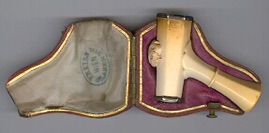What is Meerschaum?
Myra Schwartz Pipe Series


What is Meerschaum?
Myra Schwartz Pipe Series

Raw meerschaum is bright white, but pipe design
and usage brings a bounty of earth colors.
Antique Meerschaum pipes usually came in custom fitted, velvet or silk lined leather cases which were often a work of art in themselves. The diminutive Meerschaum cheroot holder & smoking case shown below was made in Vienna around 1900 and is pictured almost true to size. It was hand carved and then brought to a specialized case maker for fitting. This one is particularly unique in that the ends are open so the pipe could be smoked and stored while being encased, thus protecting the piece from stains and soil. The inside edges are lined with golden borders, creating an elegant presentation. This style case was also sometimes utilized when the pipe had an erotic theme. The pipe case could be quickly snapped shut so any women approaching would not have to see the pipe and become offended.


Closed case Opened case with cheroot pipe
The First Pipe Necklace
Artist’s Collection
For Info: email Myra at myra.schwartz@comcast.net
“Art enables us to find ourselves and lose ourselves at the same time.”
-Thomas Merton (1915-1968)
The Short Story about Meerschaum Pipes
For three centuries, Meerschaum pipes have been carved and finished by hand. The finest specimens of raw Meerschaum have always been mined in Eskisehir, Turkey, but between the 1850’s and 1920’s, the highest quality carving was done by unknown artists throughout Europe. Meerschaum pipe carving virtually exploded as a cottage industry during this era, especially in Austria, Germany and France.
By the end of World War I, smoking accessories began to go out of fashion. By the late 20’s, subject matter became less artistic, more commercial and more crudely carved. The pieces used in my series come mainly from the Victorian (1837-1901) and Edwardian eras (1901-1919).
Although Meerschaum, also known as Sepiolite, is considered a gemstone, it is quite soft when compared to other stones. When first mined and soaked, it has a soap-like consistency, making it easier to carve than other gemstones. After carving, pipes are sun or kiln dried to remove all moisture, thus hardening them. The antique pieces were often finished with special coloring agents and then meticulously waxed and polished. Smoking and handling pipes over many decades also added a unique fingerprint of color to each piece that cannot be duplicated. Each pipe I use today is truly a one-of-a-kind creation from the past which inspires me to design my signature pieces of jewelry.







© 2009-2023 All content on this website is copyrighted by Myra Schwartz. All rights reserved.
You may not reproduce any part of this website without permission.